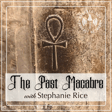
History of Fabric, Pt. 2 - Ep2
Part 2!!
Have you ever looked at a piece of knitting and wondered, “How did they figure out how to DO that with just two needles and string?” Whether you’re a picker or a thrower, those techniques had to come from somewhere, and their origins may surprise you.
Rachel Roden and Heather Boyd look at knitting techniques with the eyes of designers, through the lens of archaeology: each episode travels the world to dig up and discuss a different technique, and then applies it to a clever pattern designed by Rachel.
LinksTo get your copy of the pattern, and knit-a-long head over to Rachel’s pattern store on Ravelry (https://www.ravelry.com/designers/rachel-roden)To get the yarn Rachel recommends, head over to Jimmy Beans Wool (https://www.jimmybeanswool.com/knitting/yarn/BichesetBuches/LePetitLambswool.asp?showLarge=true&specPCVID=91487)ContactRachelRavelryInstagramTwitterFacebookWebsiteHeatherInstagramRavelry






